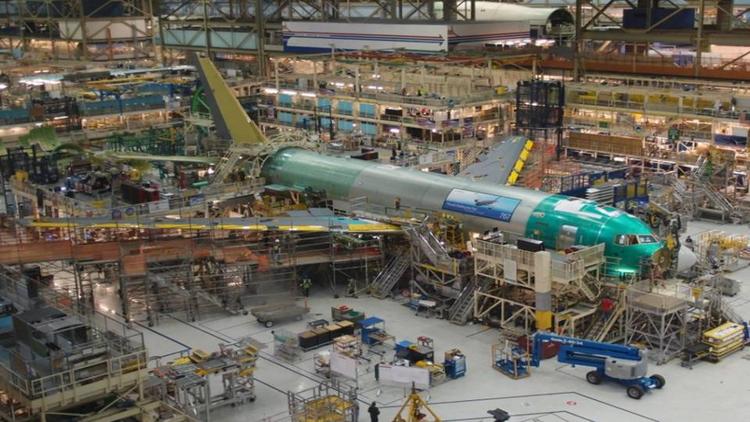
KC-46 on Boeing factory floor
WASHINGTON: A key House Armed Services Committee member yesterday vowed to use the 2022 defense authorization to address the Air Force’s “embarrassing” contract with Boeing for the troubled KC-46 tanker — as the head of Transportation Command suggested Pegasus fielding may face yet more delay.
“In my estimation, the overall procurement of this ‘commercial’ aircraft, and the penalty built into the contract requiring minimum orders of deficient airplanes, is at best procurement malpractice, or at worst an illegal binding of Congress requiring annual procurements,” Rep. Rob Wittman, ranking member of the HASC seapower and projection forces subcommittee, told a joint hearing with the HASC readiness subcommittee.
Wittman, in high dudgeon, decried Air Force “semi-triumphant messaging” about the fact that Boeing is using its own funds to rectify the myriad problems preventing the tankers from being used in combat, despite the fact that the program “continues to lag in providing relevant capability” to TRANSCOM,
Boeing’s original 2011 contract ceiling for 179 Pegasus aircraft was $4.9 billion, but the company already has spent more than that in fees to fix problems causing cost overruns and schedule delays. The Air Force in January awarded Boeing new production contracts for KC-46 lots six and seven: $1.7 billion for 12 more tankers; and $2.1 billion for 15 more, respectively. This brings the total number of tankers in production to 94.
Several other lawmakers also expressed concerns about continuing problems with the plane, including Rep. Joe Courtney, seapower subcommittee chair. “We remain concerned by the six Category 1 deficiencies on the KC-46 as of this week,” he said. (Category 1 refers to problems that could cause death, loss of the aircraft, render the aircraft incapable of performing its mission or stop the aircraft from completing testing.)
Pressed by lawmakers on the tanker fleet’s status, the outgoing head of TRANSCOM, Gen. Stephen Lyons, admitted to doubt about whether a key fix by prime contractor Boeing will be ready as promised.
“I would confess to you my view from looking at this — I think we’ve got a long way to go on the KC-46 with regard to Boeing and the work that has to be done between now and ’23. And, we’ll continue to monitor that closely, but the Air Force would be in a better place to answer that question,” he told the hearing.
The plan for Boeing to deliver a new version of the tanker’s Remote Vision System, called RVS 2.0, by 2023 for the moment is “on track,” he said. However, he stressed, delivery of the new camera — which allows operators to see where the boom is during refueling — is only a first step.
“That begins the fielding of the next iteration of the KC-46,” he said. “So, that’s just the beginning of the process. There’s a lot of retrofit that will have to take place.”
Under a deal hammered out by the Air Force last April, 12 of the new software-based camera systems are to be delivered by 2023 with installation beginning in 2024. The tankers cannot be certified as fully operational or used in combat until the new RVS 2.0 system is installed, although a small number already are performing limited refueling missions.
Wittman noted that last year Congress supported TRANSCOM’s concerns regarding planned Air Force cuts to legacy tankers, due to fears about the availability of the KC-46. The 2021 NDAA banned retirement of any KC-135 Stratotankers until Oct. 1, 2023; and set minimum fleet numbers of KC-10A aircraft of 38 in 2021 and 26 in 2022.
He added that he is glad to hear that this year TRANSCOM is on board with service fleet retirement plans in the 2022 budget request.
“We debated the overall tanker force structure last year, and supported Gen. Lyons’ minimum tanker fleet. I’m pleased to note in Gen. Lyons testimony that he supports the United States Air Force tanker retirement schedule, and I look forward to amending the FY21 NDAA to more efficiently manage our legacy tanker force structure,” Wittman said.
Lyons, in his written testimony, said “TRANSCOM is aligned with the USAF on the way ahead for the air refueling portfolio. … The current air refueling fleet is comprised of the aging KC-135 and KC-10 aircraft, and the new KC-46. We support the USAF’s plan to adjust its force structure in order to meet day-to-day and crisis requirements.”
What that plan looks like, however, is yet unclear, as DoD plans to release its 2022 budget request next Thursday. HASC deliberations are not likely to begin before the August recess.
Further, Rep. Kaialiʻi Kahele asked Lyons to elaborate on ongoing Pentagon discussions about the mix of transport aircraft now in the TRANSCOM, Air Mobility Command and National Guard C-130 fleets, and whether than might involve further reductions.
Lyons skated around a direct answer, saying only that when mobility fleet requirements are being set “the entire package of force elements” is considered. That said, he stressed that warfighter needs for theater mobility are increasing.
“When we look at some of the war plans that are evolving right now, we see a much higher demand on theater lift — not just airlift, it could also be left in the littoral. So, we’ve got to think our way through: ‘how do we continue to present multiple options and create multiple dilemmas for an adversary, and you want to be able to come out and from any direction.’ We’re working very closely with the other Combatant Commands, as well as the Air Force, to assess risk against the program, and the potential future plan reductions.”
He added: “Right now, I think we’re in a good place, but we’re watching closely as to what that profile looks like and how much risk we’re willing to accept.”
Northrop sees F-16 IVEWS, IBCS as ‘multibillion dollar’ international sales drivers
In addition, CEO Kathy Warden says the company sees a chance to sell up to five Triton UAVs to the NATO alliance.


























